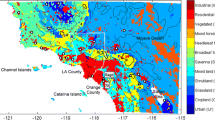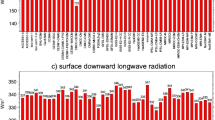Abstract
The surface energy balance has been modelled over the region of Sicily, Italy, in order to monitor the moisture status of natural vegetation and agricultural land by following the evolution of the evaporative fraction. In order to ensure the transferability of the approach throughout Europe, emphasis was placed on applying data from operationally available sources only. Daily meteorological parameters have been taken from the synoptic network, remote sensing data stem from the AVHHR sensor aboard the NOAA satellites, and land cover data have been taken from the European CORINE database.
In the one-source model EVA, the sensible heat flux has been estimated from the difference between the surface skin temperature and the surface-measured air temperature, and the formulation of a bulk aerodynamic resistance. The latent heat flux has been determined as the residual of the difference between the estimated available energy and the sensible heat flux. Additionally, daily rates of evapotranspiration have been estimated by assuming a constant evaporative fraction over the entire day. This simplistic approach is thought to make best use of the limited data available.
Validation by direct measurements of the energy balance components has been impossible, so that EVA model results had to be compared to few pan evaporation data, evapotranspiration estimates from the standard method of Priestley-Taylor and to results of the GCM of ECMWF. This comparison highlights the limited value of point measurements on the one hand and results from global circulation models on the other hand for validation purposes on the intermediate regional scale.
It is expected that near-future sensors will provide physical parameters more accurately so that more sophisticated models can be confidently applied in regions with a restricted number of ground measurements. In this sense part of the validation problem will be overcome in the future.
Access this chapter
Tax calculation will be finalised at checkout
Purchases are for personal use only
Preview
Unable to display preview. Download preview PDF.
Similar content being viewed by others
References
Ångström, A. 1924: Solar and terrestrial radiation. Quart. J. R. Met. Soc., 50, pp. 121–125.
Anderson, M.C., Norman, J.M., Diak, G.R., Kustas, W.P., and Mecikalski, J.R. 1997: A two-source time-integrated model for estimating surface fluxes using thermal infrared remote sensing. Remote Sens. Environ., 60, pp. 195–216.
Bastiaanssen, W.G.M., Pelgrum, H., Menenti, M., and Feddes, R.A. 1996: Estimation of surface resistance and Priestley-Taylor α-parameter at different scales, in: Stewart, J.B., Engman, E.T., Feddes, R.A., and Kerr, Y.H. (Eds): Scaling up in hydrology using remote sensing. Wiley, Chichester, pp. 93–111.
Businger, J.A., Wyngaard, J.C., Izumi, Y., and Bradley, E.F. 1971: Flux-profile relationships in the atmospheric surface layer. J. Atmos. Sci., 28, pp. 181–189.
Choudhury, B.J., Idso, S.B., and Reginato, R.J. 1987: Analysis of an empirical model for soil heat flux under a growing wheat crop for estimating evaporation by an infrared-temperature based energy balance equation. Agric. Forest Met., 39, pp. 283–297.
CORINE 1993: CORINE land cover — Guide technique. Publication officielle des Communautés européenne. CECA-CEE-CEEA, EUR 12585 FR, Luxembourg.
Crago, R.D. 1996: Conservation and variability of the evaporative fraction during the daytime. J. Hydrology, 180, pp. 173–194.
EOS 1995: Space_II — Architectural Design Document. Annex B. Space_II algorithm specifications, issue 2.00. Earth Observation Sciences. Internal document at Agricultureand Regional Information Systems unit, Space Applications Institute, JRC Ispra.
Eumetsat 1999: Meteosat Second Generation Opportunities for Land Surface Research and Applications. Eumetsat Scientific Publications (EUM SP 01), 67 pp.
Hargreaves, G.L., Hargreaves, G.H., and Riley, J.P. 1985: Irrigation water requirements for Senegal river basin. J. Irrig. Drainage Eng., 111, pp. 265–275.
Huntingford, C., and Monteith, J.L. 1998: The behaviour of a mixed-layer model of the convective boundary layer coupled to a big leaf model of surface energy partitioning. Bound. Layer Met., 88, pp. 87–101.
Kustas, W.P., and Norman, J.M. 1997: A two-source approach for estimating turbulent fluxes using multiple angle thermal infrared observations. Water Res. Research, 33, pp. 1495–1508.
Monteith, J.L., and Unsworth, M. 1990: Principles of environmental physics. Arnold, London; New York, 2 nd ed.
Norman, J.M., and Becker, F. 1995: Terminology in thermal infrared remote sensing of natural surfaces. Agric. Forest Met., 77, pp. 153–166.
Pinty, B., Roveda, F., Verstraete, M.M., Gobron, N., Govaerts, Y. 1999: Estimating surface albedo from the Meteosat data archive: Theory and applications. (this volume)
Priestley, C.H.B., and Taylor, R.J. 1972: On the assessment of surface heat flux and evaporation using large-scale parameters. Monthly Weather Rev., 100, pp. 81–92.
Saunders, R.W. 1990: The determination of broad band surface albedo from AVHRR visible and near-infrared radiances. Int. J. Remote Sens., 11, pp. 49–67.
Shuttleworth, W.J. 1992: Evaporation. in: Maidment, D.R. (Ed): Handbook of Hydrology. McGraw-Hill, New York, San Francisco, pp. 4.1–4.53.
Stewart, J.B., Engman, E.T., Feddes, R.A., and Kerr, Y.H. 1998: Scaling up in hydrology using remote sensing: summary of a workshop. Int. J. Remote Sens., 19, No. 1, pp. 181–194.
Supit, I. 1994: Global radiation. European Commission -Agricultural Series, EUR 15745, Luxembourg, 194 pp.
Tanré, D., Deroo, C., Duhaut, P., Herman, M., and Morcrette, J.J. 1990: Description of a computer code to simulate the satellite signal in the solar spectrum: the 5S code. Int. J.Remote Sens., 11, No. 4, pp. 659–668.
Zhang, L., and Lemeur, R. 1995: Evaluation of daily evapotranspiration estimates from instantaneous measurements. Agric. Forest Met., 74, pp. 139–154.
Author information
Authors and Affiliations
Editor information
Editors and Affiliations
Rights and permissions
Copyright information
© 2001 Kluwer Academic Publishers
About this chapter
Cite this chapter
Niemeyer, S., Vogt, J. (2001). Integration of operationally available remote sensing and synoptic data for surface energy balance modelling and environmental applications on the regional scale. In: Beniston, M., Verstraete, M.M. (eds) Remote Sensing and Climate Modeling: Synergies and Limitations. Advances in Global Change Research, vol 7. Springer, Dordrecht. https://doi.org/10.1007/0-306-48149-9_14
Download citation
DOI: https://doi.org/10.1007/0-306-48149-9_14
Publisher Name: Springer, Dordrecht
Print ISBN: 978-90-481-5648-1
Online ISBN: 978-0-306-48149-9
eBook Packages: Springer Book Archive




